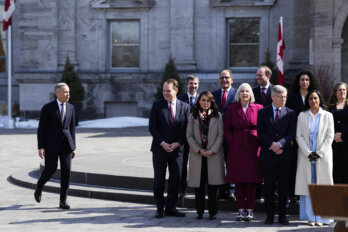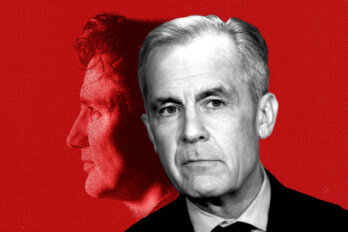Indigenous affairs were front and centre on the government’s agenda this week. Justin Trudeau devoted two-thirds of his UN speech yesterday to Canada’s failings on Indigenous relations, failings which he summarized as “humiliation, neglect, and abuse.” And on Monday, with Parliament’s resumption, he welcomed the heads of two new ministries to the front bench: the Ministry of Crown-Indigenous Relations and Northern Affairs and the Ministry of Indigenous Services.
Listen to an audio version of this story
For more Walrus audio, subscribe to AMI-audio podcasts on iTunes.
The first, under Carolyn Bennett, will be responsible for managing the nation-to-nation partnership; the second, under Jane Philpott will be responsible for the day-to-day administration and provision of services on First Nations reserves. These two ministries will replace the Ministry of Indigenous Affairs (INAC), which was split in two by Trudeau on August 28 as part of his end-of-summer cabinet shuffle. No organization in Canada’s history was quite like INAC, and it will not be missed.
INAC turned the idea of democracy on its head. Instead of power flowing from the people to their government, the Indian Act (1876) vested all power over First Nations people in the Department of Indian Affairs—later renamed INAC—which, in turn, delegated precious few responsibilities down to local First Nations authorities. The goal of INAC, and the Indian Act which created it, was, in the famous words of Duncan Campbell Scott, the superintendent general of Indian Affairs (what today we’d call a deputy minister) “to continue until there is not a single Indian in Canada that has not been absorbed into the body politic and there is no Indian question, and no Indian Department.”
With an overtly assimilationist goal, and with no accountability to the disenfranchised people over whom it ruled, INAC dominated First Nations existence with the power of an occupying army. It determined where First Nations people could live, how they could practice their faiths, what clothes they could wear, what they could drink, and where they could spend their leisure time. It prohibited First Nations people from selling agricultural products but kept for itself the right to sell, lease, or give First Nations land to non-Natives. It kept First Nations people out of certain professions and restricted their access to legal counsel, and, most damningly, INAC was responsible for the administration of the deadly residential school system. And those were just the things Parliament gave it permission to do. INAC was also responsible for the imposition of extrajudicial (i.e. “criminal”) restrictions, such as the so-called “pass system” that, up until the 1940s, required First Nations people to apply for travel documents to leave reserve for any length of time.
Even today, as INAC is in the process of being replaced, it continues to regulate First Nations life, including things such as social welfare, disability payments, and business development. It decides where you build your home and determines whether you have title over it or are a permanent tenant. Some of its greatest powers are demonstrated in what it refuses to do—for example, building standards are absent from the concern of INAC, and so are absent from most reserves. This has lead to ramshackle housing that can’t stand up to the elements, which residents are sometimes prohibited from fixing, and that is ultimately the cause of the housing crisis on many reserves.
There are few areas of First Nations life that INAC doesn’t micromanage. And First Nations officials have no choice but to abide by its verdicts. INAC does not just control the purse strings on reserve, they also have the power to strip First Nations of their already attenuated self-government and hand over their administration to private, for-profit businesses answerable only to INAC—something that is today being done to eight First Nations.
The organization is, understandably, loathed by First Nations people. Even among its own staffers, it’s held in contempt. One current INAC employee, speaking to Vice News, called the ministry a “disaster,” saying, “The huge issue no one talks about at a technical level is how poorly run the department is.” The Parliamentary Budget Office has characterized INAC decision-making as capricious, giving the example of education funding being “arbitrarily moved to other projects.” Daniel Christmas, former chief of the Membertou First Nation and now a senator, addressed the Senate on the “horrible existence” under the INAC-administered Indian Act. Referring to his time as Membertou band manager in the late ’70s, Senator Christmas said, “Pretty much our only service was the provision of social assistance: the writing out of welfare cheques every two weeks.”
When then band manager Christmas tried to break free from INAC control and build a convention centre with private capital, the ministry sent him a threatening letter, which he recalls told him that it would, “forbid the community from taking on such a financial burden.”
It’s in this context that the Trudeau government has stepped in to shutter INAC. The justification for the change, the Liberals claim, is that “the level of the ambition of this government cannot be achieved through existing colonial structures.” And there’s no doubt that INAC is a colonial structure. However, the Trudeau government overreaches when it claims that splitting INAC is the first move to get past colonialism.
It’s true that the news has been well received by some First Nations commentators (the head of the Assembly of First Nations, Perry Bellegarde, has commented that the changes “recognize the relationship between First Nations and the Crown, and reflect our right to self-determination”). But the way the Trudeau government has gone about the decision to dissolve INAC is an example of how deeply rooted those colonial structures are—even among those who feel that they are acting in the interests of First Nations people. In advance of the announcement, the Liberals prepared briefing notes for the media, and they appeared to have developed a communications strategy that involved speaking to key figures at CBC and at other media outlets. The prime minister himself even gave a speech to the staff of INAC. But what stands out is who they didn’t prepare briefing notes for and didn’t speak to.
Following the news of the overhaul, I visited and spoke with staff at the Kwantlen, Katzie, and Kwikwetlem First Nations band offices to discuss their views and expectations of the two new ministries. What I found was that my questions were the first band office staff were hearing about the reforms. Band office staff on one reserve searched faxes, letters, call records, and emails and found no communication from government about a change to our basic system of governance. As far as I could tell, there has been no apparent strategy to communicate with, let alone get the consent of, First Nations. “I work in lands and resources,” said one staffer of the change, “and only found out about the change via Twitter the day it happened.”
It’s impossible to imagine a situation in which non-Natives, let alone their own government officials, would learn of a change of this magnitude via social media. This is a prime example of what First Nations activists mean by “colonialism”—when a change that affects our way of life is made without our knowledge or consent, and we have no recourse but to accept it. That is precisely the same colonialism Canada’s founders rejected when the Act of Union—the shotgun marriage between the Upper Canada and Lower Canada—was imposed on them in a similar fashion in 1841.
Mixed with the reek of colonialism are whiffs of improvisation. While the idea of splitting the ministry in two first appeared in the 1996 Royal Commission on Aboriginal Peoples’s (RCAP) report, it has spent two decades buried on a shelf along with recommendations that included a new Royal Proclamation on Indigenous rights and a constitutional change to create a tricameral federal Parliament with an Indigenous House joining the Commons and the Senate.
References to the RCAP didn’t appear in any Liberal campaign promises, and a search of the Liberal website shows just three tangential mentions of the RCAP (from 2010, 2012, and 2014). The RCAP wasn’t mentioned in a throne speech, a budget speech, or anywhere else that actions of this significance would otherwise be seen. In fact, as recently as June of this year, Trudeau ruled out some the RCAP’s recommendations, saying, “We are not opening the constitution.”
Rather than systematically implementing RCAP’s recommendations, it appears that they’re using the report—along wih the Truth and Reconciliation Commission and the dozens of other reports on the oppression of Indigenous Canada—as a suggestion box to turn to when they’re in trouble. And, make no mistake, they are in trouble. With their reconciliation agenda facing a backlash from Indigenous people, the Liberals have spent the summer reaching out to First Nations. Trudeau and his official photographer conducted a listening tour in his kayak. And now, we see this change to INAC. But it’s a change that came out of the blue and was largely without content. In the press release announcing the creation of the two new ministries, the government writes that “a key part of the Minister’s mandate will be to lead a consultation process to determine how best to replace INAC with the two new departments.”
This brings to mind the expression: “kill them all and let God sort it out.” That is, in effect, with the Liberals have done here: they’ve axed a ministry and are leaving it to the minister to figure out what to do next. Whether that kind of uncertainty can improve conditions on impoverished First Nations reserves is open to debate. But the best that can be said about this absence of content is that it can, in a way, be an opportunity.
We have the chance for a clean start—but that can’t be done in Ottawa. There’s a case to be made that the Ministry of Crown-Indigenous Relations needs to be near the centre of government, where the decision-makers live. But the new Ministry of Indigenous Services—the body that has day-to-day supervision over Indigenous affairs—ought to be closer to us, closer to where Indigenous people live. It ought to be in Winnipeg.
The exact mission of Indigenous Services isn’t yet clear. The government, however, have already given hints that it may end up being a sort of “super ministry” that will centralize all service delivery to reserves, including potentially those few services presently managed by other groups, such as the Ministry of Health and Fisheries and Oceans Canada. In truth, this would make Indigenous Services even more powerful than INAC was.
If Canada isn’t going to repeat the mistakes of INAC, the Ministry of Indigenous Services must fix INAC’s greatest failing—its lack of accountability to the people it governs. First Nations people don’t have a voice in the federal government because our communities are, for the most part, buried in predominantly non-Native districts. Of Canada’s 308 electoral districts, First Nations people form the majority in just two ridings: Churchill–Keewatinook Aski in Manitoba and Desnethé–Missinippi–Churchill River in Saskatchewan. With our population diluted into different electoral districts, we have no guaranteed presence in the House of Commons or the Senate, so we have had no way to hold INAC accountable. While there is responsible government in Canada, it is not responsible to us.
In fact, when responsibility and accountability are mentioned in proximity to our First Nations governments, it is most often done as part of a veiled attack on the legitimacy of First Nations people; to make us answer to INAC and to the federal parliament, and not vice versa. It should not be forgotten that until very recently the Senate Committee overseeing Indigenous Affairs, one of the many bodies to whom we were to be held to account, included disgraced senator Lynn Beyak—a person who used her position to berate Residential School survivors and to threaten them with “a national audit of all dollars coming in and out of all reserves.”
Locating the new Ministry of Indigenous Services in Winnipeg wouldn’t fix the democratic deficit, but it would mitigate it. Ottawa has a very small First Nations population, under 10,000 people, and only a scattering of First Nations organizations, many of whom are hostile to INAC. Career prospects for a First Nations employee of INAC are limited to that organization alone. To advance, the employee has to become an INAC careerist, prove to their non-Native colleagues their allegiance to INAC ideals and INAC ways of thinking, and show that they hold the interests of INAC over the interests dictated by their First Nations identity. In doing so, however, they can cut themselves off from First Nations society and from accountability to their own communities.
Winnipeg, by contrast, is home to 72,000 First Nations people. It’s the headquarters of APTN and a half dozen Indigenous financial institutions. In a sense, it’s Main Street for Indigenous Canada, with a depth of cultural institutions and NGOs serving our people. Placing the new Ministry of Indigenous Services in this setting would give it access to a larger and more connected group of First Nations employees. It would draw on people who had worked in First Nations–led institutions and open to them a career path that includes lateral moves from Indigenous Services into those First Nations institutions. It would free Indigenous employees of Indigenous Services from the chain of INAC careerism. It could mean that instead of holding First Nations people in contempt, the new ministry would be home to Indigenous employees who had to treat First Nations people with respect—or risk cutting themselves off from career opportunities outside of the ministry.
“The time has come,” said Trudeau before the UN, “to get off the beaten path.” If there is really appetite for making bold moves, then Trudeau must make this one great leap towards responsibility and accountability. Canadians cherish their right to hold those who rule them to account. If splitting INAC doesn’t result in a massive evolution towards making government responsible to First Nations people, then the Ministry of Indigenous Services will be yet another in a long line of colonial tools.




